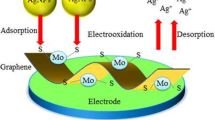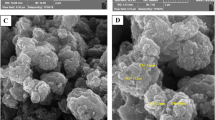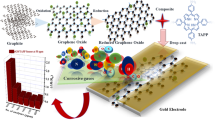Abstract
This study presents the fabrication and application of a graphene-assisted voltammetry platform for the sensitive detection of nitrate ions in PM2.5 (atmospheric aerosols with a maximum diameter of 2.5 µm). The MoS2/reduced graphene oxide/glassy carbon electrode (MoS2/rGO/GCE) was prepared using a simple and efficient electrochemical deposition method. The rationale behind selecting MoS2/rGO stems from their individual properties that, when combined, can enhance the electrode’s performance. MoS2 offers excellent electro-catalytic activity and selectivity for nitrate ion detection, while rGO provides high conductivity and a large surface area for enhanced sensitivity. The electrochemical performance of MoS2/rGO/GCE was investigated and compared with MoS2/GCE and bare GCE using cyclic voltammetry and electrochemical impedance spectroscopy. The results demonstrated that MoS2/rGO/GCE exhibited enhanced electro-catalytic activity, high conductivity, and improved selectivity for nitrate ion detection. The optimal pH value for detecting nitrate ions was determined to be 8.0. Differential pulse voltammetry (DPV) was employed to investigate the linear range and detection limit of nitrate ions on MoS2/rGO/GCE, resulting in a linear range from 1 to 300 μM and a detection limit of 0.35 μM. The reproducibility and the stability of MoS2/rGO/GCE were assessed, showing satisfactory performance. Real sample analysis from Chengdu City showed a strong correlation between the results obtained using MoS2/rGO/GCE and ion chromatography, highlighting its potential application in monitoring nitrate ions in PM2.5. The findings of this study contribute to the development of a graphene-assisted voltammetry platform for sensitive nitrate ion detection in PM2.5, offering potential benefits for real-time air pollution monitoring and environmental health assessments.








Similar content being viewed by others
Data availability
The data that support the findings of this study are available from the corresponding author upon reasonable request.
References
Xiao Q, Geng G, Liang F, Wang X, Lv Z, Lei Y, Huang X, Zhang Q, Liu Y, He K (2020) Changes in spatial patterns of PM25 pollution in China 2000–2018: impact of clean air policies. Environ Int 141:105776
Luo X, Sun K, Li L, Wu S, Yan D, Fu X, Luo H (2021) Impacts of urbanization process on PM2.5 pollution in" 2+ 26" cities. J Clean Prod 284:124761
Sorek-Hamer M, Chatfield R, Liu Y (2020) Strategies for using satellite-based products in modeling PM2.5 and short-term pollution episodes. Environ Int 144:106057
Yue H, He C, Huang Q, Yin D, Bryan BA (2020) Stronger policy required to substantially reduce deaths from PM2.5 pollution in China. Nat Commun 11:1462
Zhao X, Zhou W, Wu T, Han L (2022) The impacts of urban structure on PM2.5 pollution depend on city size and location. Environ Pollut 292:118302
Cheng Z, Li L, Liu J (2020) The impact of foreign direct investment on urban PM2.5 pollution in China. J Environ Manag 265:110532
Ghosh R, Causey K, Burkart K, Wozniak S, Cohen A, Brauer M (2021) Ambient and household PM2.5 pollution and adverse perinatal outcomes: a meta-regression and analysis of attributable global burden for 204 countries and territories. PLoS Med 18:e1003718
Li Y, Geng Y, Hu X, Yin X (2022) Seasonal differences in sources and formation processes of PM2.5 nitrate in an urban environment of North China. J Environ Sci 120:94–104
Zhu Y, Lv Z (2022) Determination of water-soluble nitrate ions in PM2.5 particles using UiO-67 modified glassy carbon electrode. Int J Electrochem Sci 17:221024
Li Q, Li X-D, Yang Z, Cui G, Ding S (2021) Diurnal and seasonal variations in water-soluble inorganic ions and nitrate dual isotopes of PM2.5: implications for source apportionment and formation processes of urban aerosol nitrate. Atmospheric Res 248:105197
Su J, Zhao P, Ding J, Du X, Dou Y (2021) Insights into measurements of water-soluble ions in PM2.5 and their gaseous precursors in Beijing. J Environ Sci 102:123–137
Tian Y, Wang X, Zhao P, Shi Z, Harrison RM (2023) PM2.5 source apportionment using organic marker-based chemical mass balance modeling: influence of inorganic markers and sensitivity to source profiles. Atmos Environ 294:119477
Wang S, Kaur M, Li T, Pan F (2021) Effect of different pollution parameters and chemical components of PM2.5 on health of residents of Xinxiang City, China. Int J Environ Res Public Health 18:6821
Liu C, Wang H, Guo H (2019) Redistribution of PM2.5-associated nitrate and ammonium during outdoor-to-indoor transport. Indoor Air 29:460–468
Yamazaki S, Shima M, Yoda Y, Kurosaka F, Isokawa T, Shimizu S, Ogawa T, Kamiyoshi N, Terada K, Nishikawa J (2019) Association between chemical components of PM2. 5 and children’s primary care night-time visits due to asthma attacks: a case-crossover study. Allergol Int 68:329–334
Guan R, Yu J, Li M, Yan J, Liu Z (2021) Preparation of electrochemical sensor assisted unmanned aerial vehicles system for SO2, O3, NO2, CO and PM2.5/PM10 detection in air. Int J Electrochem Sci 16:211021
Yu L, Zhang Q, Jin D, Xu Q, Hu X (2019) A promising voltammetric biosensor based on glutamate dehydrogenase/Fe3O4/graphene/chitosan nanobiocomposite for sensitive ammonium determination in PM2. 5. Talanta 197:622–630
Arroyo P, Meléndez F, Rodriguez S, Suárez JI, Carretero S, Cerrato M, Pinilla-Gil E, Lozano J (2020) Low cost system for air quality measurement based on electrochemical and optical sensors. Sens Transducers 246:9–15
Berg KE, Turner LR, Benka-Coker ML, Rajkumar S, Young BN, Peel JL, Clark ML, Volckens J, Henry CS (2019) Electrochemical dithiothreitol assay for large-scale particulate matter studies. Aerosol Sci Technol 53:268–275
Yin H, Parsnejad S, Ashoori E, Wan H, Li W, Mason AJ (2021) Size-fractionated electrochemical quantification for compact monitoring of fine particulate matter. Microchem J 168:106386
Tahernejad-Javazmi F, Shabani-Nooshabadi M, Karimi-Maleh H (2019) 3D reduced graphene oxide/FeNi3-ionic liquid nanocomposite modified sensor; an electrical synergic effect for development of tert-butylhydroquinone and folic acid sensor. Compos Part B Eng 172:666–670. https://doi.org/10.1016/j.compositesb.2019.05.065
Misaghpour F, Shabani-Nooshabadi M (2018) An electrochemical sensor for analysis of food red 17 in the presence of tartrazine in food products amplified with CdO/rGO nanocomposite and 1,3-dipropylimidazolium bromide. Food Anal Methods 11:646–653. https://doi.org/10.1007/s12161-017-1035-7
Tahernejad-Javazmi F, Shabani-Nooshabadi M, Karimi-Maleh H (2018) Analysis of glutathione in the presence of acetaminophen and tyrosine via an amplified electrode with MgO/SWCNTs as a sensor in the hemolyzed erythrocyte. Talanta 176:208–213. https://doi.org/10.1016/j.talanta.2017.08.027
Shabani-Nooshabadi M, Tahernejad-Javazmi F (2015) Electrocatalytic determination of hydroxylamine in the presence of thiosulfate in water and wastewater samples using a nanostructure modified carbon paste electrode. Electroanalysis 27:1733–1741. https://doi.org/10.1002/elan.201500046
Bisht N, Patel M, Dwivedi N, Kumar P, Mondal DP, Srivastava AK, Dhand C (2023) Bio-inspired polynorepinephrine based nanocoatings for reduced graphene oxide/gold nanoparticles composite for high-performance biosensing of Mycobacterium tuberculosis. Environ Res 227:115684. https://doi.org/10.1016/j.envres.2023.115684
Karimi-Maleh H, Liu Y, Li Z, Darabi R, Orooji Y, Karaman C, Karimi F, Baghayeri M, Rouhi J, Fu L, Rostamnia S, Rajendran S, Sanati AL, Sadeghifar H, Ghalkhani M (2023) Calf thymus ds-DNA intercalation with pendimethalin herbicide at the surface of ZIF-8/Co/rGO/C3N4/ds-DNA/SPCE; a bio-sensing approach for pendimethalin quantification confirmed by molecular docking study. Chemosphere 332:138815. https://doi.org/10.1016/j.chemosphere.2023.138815
Nodehi M, Baghayeri M, Veisi H (2021) Preparation of GO/Fe3O4@PMDA/AuNPs nanocomposite for simultaneous determination of As3+ and Cu2+ by stripping voltammetry. Talanta 230:122288. https://doi.org/10.1016/j.talanta.2021.122288
Karimi-Maleh H, Beitollahi H, Senthil Kumar P, Tajik S, Mohammadzadeh Jahani P, Karimi F, Karaman C, Vasseghian Y, Baghayeri M, Rouhi J, Show PL, Rajendran S, Fu L, Zare N (2022) Recent advances in carbon nanomaterials-based electrochemical sensors for food azo dyes detection. Food Chem Toxicol 164:112961. https://doi.org/10.1016/j.fct.2022.112961
Ermis N, Zare N, Darabi R, Alizadeh M, Karimi F, Singh J, Shahidi S-A, Dragoi EN, Camarada MB, Baghayeri M (2023) Recent advantage in electrochemical monitoring of gallic acid and kojic acid: a new perspective in food science. J Food Meas Charact. https://doi.org/10.1007/s11694-023-01881-0
Jafari Y, Shabani-Nooshabadi M, Ghoreishi SM (2014) Electropolymerized coatings of poly(o-anisidine) and poly(o-anisidine)-TiO2 nanocomposite on aluminum alloy 3004 by using the galvanostatic method and their corrosion protection performance. Polym Adv Technol 25:279–287. https://doi.org/10.1002/pat.3233
Akbarian Y, Shabani-Nooshabadi M, Karimi-Maleh H (2018) Fabrication of a new electrocatalytic sensor for determination of diclofenac, morphine and mefenamic acid using synergic effect of NiO-SWCNT and 2, 4-dimethyl-N/-[1- (2, 3-dihydroxy phenyl) methylidene] aniline. Sens Actuators B Chem 273:228–233. https://doi.org/10.1016/j.snb.2018.06.049
Shabani-Nooshabadi M, Karimi-Maleh H, Tahernejad-Javazmi F (2019) Fabrication of an electroanalytical sensor for determination of deoxyepinephrine in the presence of uric acid using CuFe2O4 nanoparticle/ionic liquid amplified sensor. J Electrochem Soc 166:H218. https://doi.org/10.1149/2.1261906jes
Darabi R, Shabani-Nooshabadi M (2021) NiFe2O4-rGO/ionic liquid modified carbon paste electrode: an amplified electrochemical sensitive sensor for determination of Sunset Yellow in the presence of Tartrazine and Allura Red. Food Chem 339:127841. https://doi.org/10.1016/j.foodchem.2020.127841
Fu L, Mao S, Chen F, Zhao S, Su W, Lai G, Yu A, Lin C-T (2022) Graphene-based electrochemical sensors for antibiotic detection in water, food and soil: a scientometric analysis in CiteSpace (2011–2021). Chemosphere 297:134127
Liu F, Wang C, Sui X, Riaz MA, Xu M, Wei L, Chen Y (2019) Synthesis of graphene materials by electrochemical exfoliation: Recent progress and future potential. Carbon Energy 1:173–199
Ye C, Zhu Y, Sun H, Chen F, Sun H, Dai W, Wei Q, Fu L, Yu A, Du S, Yang M, Huang L-F, Yu J, Jiang N, Lin C-T (2021) Layer-by-layer stacked graphene nanocoatings by Marangoni self-assembly for corrosion protection of stainless steel. Chin Chem Lett 32:501–505. https://doi.org/10.1016/j.cclet.2020.03.013
Cai C, Wang T, Qu G, Feng Z (2021) High thermal conductivity of graphene and structure defects: prospects for thermal applications in graphene sheets. Chin Chem Lett 32:1293–1298. https://doi.org/10.1016/j.cclet.2020.10.030
Zhu H, Zhang B, Zhu N, Li M, Yu Q (2021) Mitochondrion targeting peptide-modified magnetic graphene oxide delivering mitoxantrone for impairment of tumor mitochondrial functions. Chin Chem Lett 32:1220–1223. https://doi.org/10.1016/j.cclet.2020.09.003
Chu Y, Xi B, Xiong S (2021) One-step construction of MoO2 uniform nanoparticles on graphene with enhanced lithium storage. Chin Chem Lett 32:1983–1987. https://doi.org/10.1016/j.cclet.2020.10.024
Hao C, Gao T, Yuan A, Xu J (2021) Synthesis of iron oxide cubes/reduced graphene oxide composite and its enhanced lithium storage performance. Chin Chem Lett 32:113–118. https://doi.org/10.1016/j.cclet.2020.11.038
Krishnan SK, Singh E, Singh P, Meyyappan M, Nalwa HS (2019) A review on graphene-based nanocomposites for electrochemical and fluorescent biosensors. RSC Adv 9:8778–8881
Tao T, Zhou Y, Ma M, He H, Gao N, Cai Z, Chang G, He Y (2021) Novel graphene electrochemical transistor with ZrO2/rGO nanocomposites functionalized gate electrode for ultrasensitive recognition of methyl parathion. Sens Actuators B Chem 328:128936
Cheraghi S, Taher MA, Karimi-Maleh H, Karimi F, Shabani-Nooshabadi M, Alizadeh M, Al-Othman A, Erk N, Yegya Raman PK, Karaman C (2022) Novel enzymatic graphene oxide based biosensor for the detection of glutathione in biological body fluids. Chemosphere 287:132187. https://doi.org/10.1016/j.chemosphere.2021.132187
Tahernejad-Javazmi F, Shabani-Nooshabadi M, Karimi-Maleh H, Naeimi H (2018) Square wave voltammetric determination of hydrazine and 4-chlorophenol as two important water pollutants using nanostructure-amplified sensor. Res Chem Intermed 44:5389–5401. https://doi.org/10.1007/s11164-018-3429-6
Tahernejad-Javazmi F, Shabani-Nooshabadi M (2017) Voltammetric determination of thiosulfate in presence of p-nitrophenol using an electrochemical nanostructure sensor modified with a new mediator. J Electrochem Soc 164:H975. https://doi.org/10.1149/2.0081714jes
Ding X, Li M, Jin J, Huang X, Wu X, Feng L (2022) Graphene aerogel supported Pt-Ni alloy as efficient electrocatalysts for alcohol fuel oxidation. Chin Chem Lett 33:2687–2691. https://doi.org/10.1016/j.cclet.2021.09.076
Wang Z, Fu W, Hu L, Zhao M, Guo T, Hrynsphan D, Tatsiana S, Chen J (2021) Improvement of electron transfer efficiency during denitrification process by Fe-Pd/multi-walled carbon nanotubes: possessed redox characteristics and secreted endogenous electron mediator. Sci Total Environ 781:146686. https://doi.org/10.1016/j.scitotenv.2021.146686
Xia H, Zan L, Yuan P, Qu G, Dong H, Wei Y, Yu Y, Wei Z, Yan W, Hu J-S, Deng D, Zhang J-N (2023) Evolution of stabilized 1T-MoS2 by atomic-interface engineering of 2H-MoS2/Fe−Nx towards enhanced sodium ion storage. Angew Chem 135:e202218282. https://doi.org/10.1002/ange.202218282
Chen H, Xu C, Zhao F, Geng C, Liu Y, Zhang J, Kang Q, Li Z (2023) Designing the anti-biofouling surface of an ultrafiltration membrane with a novel zwitterionic poly(aryl ether oxadiazole) containing benzimidazole. Appl Surf Sci 609:155447. https://doi.org/10.1016/j.apsusc.2022.155447
Chang K, Chen W (2011) L-cysteine-assisted synthesis of layered MoS2/graphene composites with excellent electrochemical performances for lithium ion batteries. ACS Nano 5:4720–4728
Karaman C, Bölükbaşı ÖS, Yola BB, Karaman O, Atar N, Yola ML (2022) Electrochemical neuron-specific enolase (NSE) immunosensor based on CoFe2O4@ Ag nanocomposite and AuNPs@ MoS2/rGO. Anal Chim Acta 1200:339609
Zhang Y, Ju P, Zhao C, Qian X (2016) In-situ grown of MoS2/RGO/MoS2@ Mo nanocomposite and its supercapacitor performance. Electrochim Acta 219:693–700
Kıranşan KD, Topçu E (2018) Free-standing and flexible MoS2/rGO paper electrode for amperometric detection of folic acid. Electroanalysis 30:810–818
Shen P, Yang X, Du M, Zhang H (2021) Temperature and laser-power dependent Raman spectra of MoS2/RGO hybrid and few-layered MoS2. Phys B Condens Matter 604:412693
Liu Y-R, Shang X, Gao W-K, Dong B, Chi J-Q, Li X, Yan K-L, Chai Y-M, Liu Y-Q, Liu C-G (2017) Ternary CoS2/MoS2/RGO electrocatalyst with CoMoS phase for efficient hydrogen evolution. Appl Surf Sci 412:138–145
Wang K, Zhan Z, Lei T, Yin P (2020) Cu–MoS2/rGO hybrid material for enhanced hydrogen evolution reaction performance. Int J Hydrog Energy 45:9773–9782
Li F, Zhang L, Li J, Lin X, Li X, Fang Y, Huang J, Li W, Tian M, Jin J (2015) Synthesis of Cu–MoS2/rGO hybrid as non-noble metal electrocatalysts for the hydrogen evolution reaction. J Power Sources 292:15–22
Fu L, Yu S, Thompson L, Yu A (2015) Development of a novel nitrite electrochemical sensor by stepwise in situ formation of palladium and reduced graphene oxide nanocomposites. RSC Adv 5:40111–40116. https://doi.org/10.1039/C5RA02661J
Madhu R, Veeramani V, Chen S-M (2014) Heteroatom-enriched and renewable banana-stem-derived porous carbon for the electrochemical determination of nitrite in various water samples. Sci Rep 4:4679. https://doi.org/10.1038/srep04679
Nasraoui S, Al-Hamry A, Teixeira PR, Ameur S, Paterno LG, Ben Ali M, Kanoun O (2021) Electrochemical sensor for nitrite detection in water samples using flexible laser-induced graphene electrodes functionalized by CNT decorated by Au nanoparticles. J Electroanal Chem 880:114893. https://doi.org/10.1016/j.jelechem.2020.114893
Li X, Zou N, Wang Z, Sun Y, Li H, Gao C, Wang T, Wang X (2020) An electrochemical sensor for determination of nitrite based on Au nanoparticles decorated MoS2 nanosheets. Chem Pap 74:441–449. https://doi.org/10.1007/s11696-019-00885-9
Chen G, Zheng J (2021) Non-enzymatic electrochemical sensor for nitrite based on a graphene oxide–polyaniline–au nanoparticles nanocomposite. Microchem J 164:106034. https://doi.org/10.1016/j.microc.2021.106034
Funding
The research is supported by the 2022 Graduate Innovation Fund of Xihua University (No: YCJJ2021083).
Author information
Authors and Affiliations
Contributions
Conceptualization, HL and CW; software, HL and YZ; validation, YZ and KF; formal analysis, HL and KF; investigation, YZ and KF; resources, CW; data curation, YZ and KF; writing—original draft preparation, HL; writing—review and editing, YZ, KF and CW; visualization, YZ; supervision, HL; project administration, CW. All authors have read and agreed to the published version of the manuscript.
Corresponding author
Ethics declarations
Conflict of interest
On behalf of all authors, the corresponding author states that there is no conflict of interest.
Additional information
Publisher's Note
Springer Nature remains neutral with regard to jurisdictional claims in published maps and institutional affiliations.
Rights and permissions
Springer Nature or its licensor (e.g. a society or other partner) holds exclusive rights to this article under a publishing agreement with the author(s) or other rightsholder(s); author self-archiving of the accepted manuscript version of this article is solely governed by the terms of such publishing agreement and applicable law.
About this article
Cite this article
Li, H., Zhang, Y., Feng, K. et al. Fabrication of graphene-assisted voltammetry platform for the detection of nitrate ions in PM2.5. Carbon Lett. 33, 2143–2152 (2023). https://doi.org/10.1007/s42823-023-00585-1
Received:
Revised:
Accepted:
Published:
Issue Date:
DOI: https://doi.org/10.1007/s42823-023-00585-1




